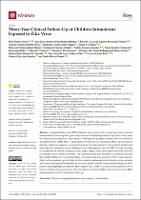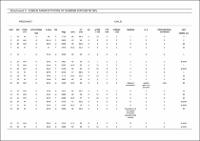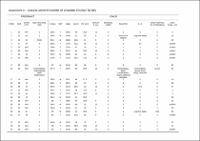| dc.contributor | Vall d'Hebron Barcelona Hospital Campus |
| dc.contributor.author | Gazeta, Rosa Estela |
| dc.contributor.author | Bertozzi, Ana Paula Antunes Pascalicchio |
| dc.contributor.author | Dezena, Rita de Cássia de Aguirre Bernardes |
| dc.contributor.author | Silva, Andrea Cristina Botelho |
| dc.contributor.author | Fajardo, Thamirys Cosmo Gillo |
| dc.contributor.author | Catalan, Daniel T. |
| dc.contributor.author | Soriano Arandes, Antoni |
| dc.date.accessioned | 2021-11-19T08:42:19Z |
| dc.date.available | 2021-11-19T08:42:19Z |
| dc.date.issued | 2021-03-22 |
| dc.identifier.citation | Gazeta RE, Bertozzi APAP, Dezena RCAB, Silva ACB, Fajardo TCG, Catalan DT, et al. Three-Year Clinical Follow-Up of Children Intrauterine Exposed to Zika Virus. Viruses. 2021 Mar 22;13:523. |
| dc.identifier.issn | 1999-4915 |
| dc.identifier.uri | https://hdl.handle.net/11351/6566 |
| dc.description | Zika virus; Congenital infection; Microcephaly |
| dc.description.abstract | Congenital Zika virus (ZIKV) infection may present with a broad spectrum of clinical manifestations. Some sequelae, particularly neurodevelopmental problems, may have a later onset. We conducted a prospective cohort study of 799 high-risk pregnant women who were followed up until delivery. Eighty-three women and/or newborns were considered ZIKV exposed and/or infected. Laboratory diagnosis was made by polymerase chain reaction in the pregnant mothers and their respective newborns, as well as Dengue virus, Chikungunya virus, and ZIKV serology. Serology for toxoplasmosis, rubella, cytomegalovirus, herpes simplex virus, and syphilis infections were also performed in microcephalic newborns. The newborns included in the study were followed up until their third birthday. Developmental delay was observed in nine patients (13.2%): mild cognitive delay in three patients, speech delay in three patients, autism spectrum disorder in two patients, and severe neurological abnormalities in one microcephalic patient; sensorineural hearing loss, three patients and dysphagia, six patients. Microcephaly due to ZIKV occurred in three patients (3.6%). Clinical manifestations can appear after the first year of life in children infected/exposed to ZIKV, emphasizing the need for long-term follow-up. |
| dc.language.iso | eng |
| dc.publisher | MDPI |
| dc.relation.ispartofseries | Viruses;13 |
| dc.rights | Attribution 4.0 International |
| dc.rights.uri | http://creativecommons.org/licenses/by/4.0/ |
| dc.source | Scientia |
| dc.subject | Arbovirosis |
| dc.subject | Infants |
| dc.subject | Embaràs - Complicacions |
| dc.subject.mesh | Zika Virus Infection |
| dc.subject.mesh | Pregnancy Complications, Infectious |
| dc.subject.mesh | Child, Preschool |
| dc.title | Three-Year Clinical Follow-Up of Children Intrauterine Exposed to Zika Virus |
| dc.type | info:eu-repo/semantics/article |
| dc.identifier.doi | 10.3390/v13030523 |
| dc.subject.decs | infección por el virus del Zika |
| dc.subject.decs | complicaciones infecciosas del embarazo |
| dc.subject.decs | niño preescolar |
| dc.relation.publishversion | https://doi.org/10.3390/v13030523 |
| dc.type.version | info:eu-repo/semantics/publishedVersion |
| dc.audience | Professionals |
| dc.contributor.organismes | Institut Català de la Salut |
| dc.contributor.authoraffiliation | [Gazeta RE, Bertozzi APAP] Pediatrics Department, Jundiaí Medical School, Jundiaí 13202-550, Brazil. [Dezena RCAB] University Center Campo Limpo Paulista-UNIFACCAMP, Campo Limpo Paulista, São Paulo 13231-230, Brazil. [Silva ACB, Fajardo TCG, Catalan DT] . Pediatric Infectology Laboratory, Jundiaí Medical School, Jundiaí 13202-550, Brazil. [Soriano-Arandes A] Unitat de Patologia Infecciosa i Immunodeficiències de Pediatria, Vall d’Hebron Hospital Universitari, Barcelona, Spain. Vall d’Hebron Institut de Recerca (VHIR), Barcelona, Spain. Universitat Autònoma de Barcelona, Bellaterra, Spain |
| dc.identifier.pmid | 33810110 |
| dc.identifier.wos | 000634247700001 |
| dc.rights.accessrights | info:eu-repo/semantics/openAccess |





